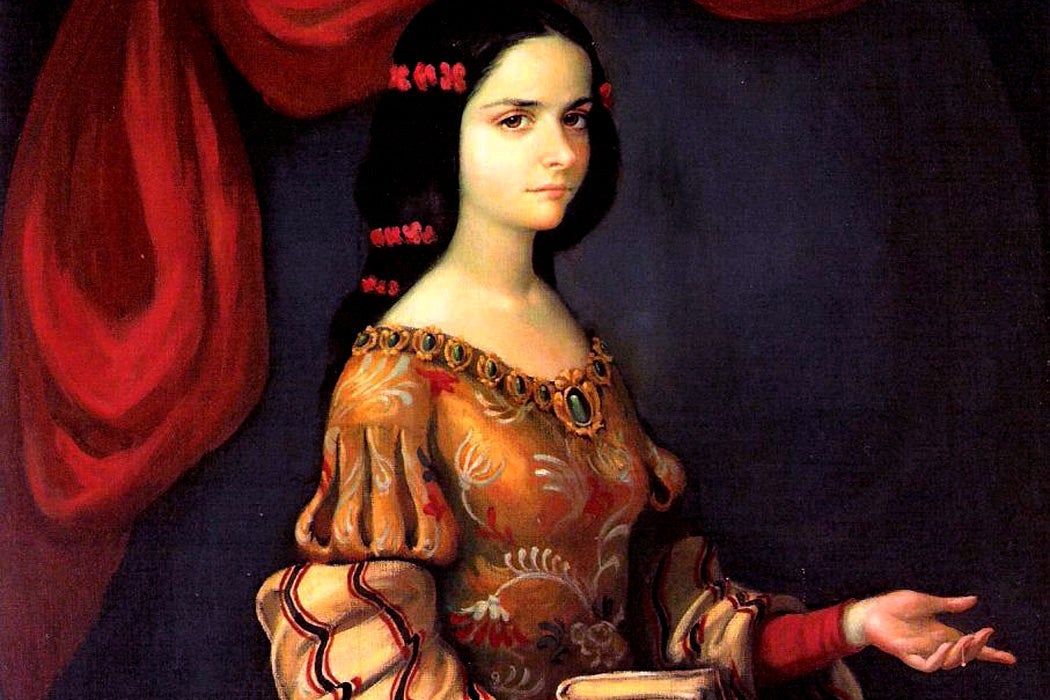From a convent in New Spain, Sor Juana Inés de la Cruz became one of the leading lights of the Spanish Baroque’s golden age. A scholar, poet, playwright, philosopher, and composer, in her lifetime Sor Juana (1648-1695) was known as the Tenth Muse and the Phoenix of America. Condemned by the male hierarchy of the Catholic Church, she has since become a Hispanic/Chicana/Latina feminist icon and a founding mother of Mexican literature.
Sure, she was brilliant and multilingual, writing in Latin and Nahuatl, but how did she do all this from inside a cloister? Good prep work, evidently. Before joining the convent, she educated herself in a library inherited from her grandfather. As an adolescent, she became a lady-in-waiting to the viceroy’s wife. Her brains and wit earned her renown in the royal court; a group of forty scholars tested her and granted her the equivalent of a university degree (otherwise impossible for a woman to get). Once inside the convent—a life choice that was virtually the only alternative to marriage—Sor Juana ran a salon for the intellectual elite of Mexico City.
Ryan Prendergast writes that her influential secular allies allowed her “to exist—at least textually—outside of the convent.” He writes:
patronage by these powerful allies resulted in the publication of her work in Spain, which circulated in a secular, often courtly, milieu. The relationships she established with the viceregal couples of New Spain assured her of protection from her detractors—most of them men of the cloth—who perceived her writing to be audacious, blasphemous, and unbefitting a woman, let alone a cloistered nun.
The Church did eventually force her to give up her library and writing in 1694. She died the following year. She had, however, already published the body of work that made her reputation. This includes poetry, particularly her masterpiece Primero sueño (The Dream), comedies, dramas, and La Respuesta (The Answer or The Reply). This last was a passionately autobiographical defense of women’s intellectual rights and abilities. It was written in response to a Bishop’s criticism that she was too preoccupied with secular learning. The Bishop wrote his accusations under a female pen-name, pretending to be another Sor, or Sister.
Sor Juana, writes Prendergast, represented “her intellect and curiosity as a natural gift from God.” Her scholarly knowledge was on display in La Respuesta, along with a lengthy list of women the Church itself praised for their intellectual abilities.
Not only could she intellectually outdo the Bishop, but Sor Juana was also a comedian. Julie Greer Johnson focuses on this aspect of her work. This might be the most revolutionary thing about Sor Juana, for it was highly unusual for a woman writer to use humor. Women were much more generally the targets of condescending and misogynist humor and satire.
Weekly Digest
She used humor, writes Johnson, to “call attention to the inequality of male-female relationships in a non-confrontational manner and make women aware of the masculine images of femininity imposed upon them.” Her satires took on the double standard of men who solicit sex outside marriage while insisting on marrying virgins. Johnson also notes:
In her theatrical comedy, Losempeños de una casa ( The House of Trials), which was performed in Mexico City in 1683 … Sor Juana attempts, through the use of cross-dressing, to make women aware of the images being imposed upon them…. Sor Juana puts a man in a woman’s place [and clothes] in order to represent the degrading treatment women often received from men, at the same time revealing the stupidity of some patriarchal figures, who … base their entire view of womanhood on physical appearances.
Sor Juana appropriated the power of laughter on behalf of women. Nearly three and a quarter centuries after her death, her work sounds remarkably contemporary.







